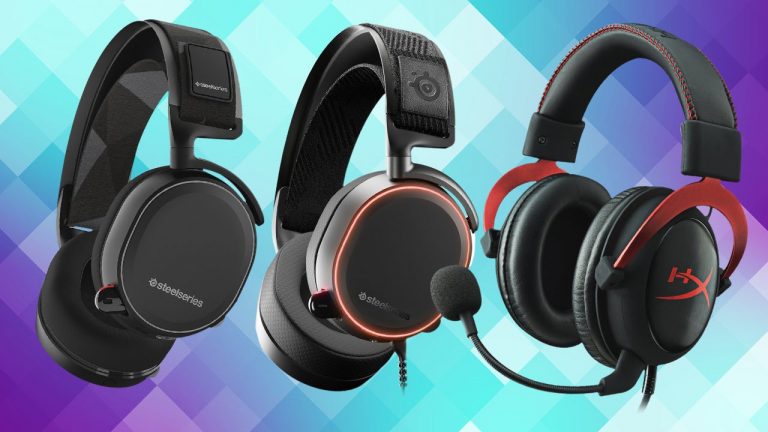7 Best Headphones for Recording Vocals 2023
A pair of studio headphones that offer effective sound isolation is the primary requirement for recording tracks. Without it, you’ll struggle with sound bleeding into the mic and end up with unnecessary noise in the recording.
We tested out several studio headphones, including open and closed-back types. While closed-back headsets turned out better at isolation and more suitable for recording vocals, open-back headphones offered better sound quality, which makes them appropriate for mixing and editing.
However, because this guide is recording-focused, we have more options for closed-back headphones. So let’s get into the 7 best headphones for recording vocals.
Contents
Which Are The Best Headphones for Recording Vocals?
1. Audio-Technica ATH-M50X
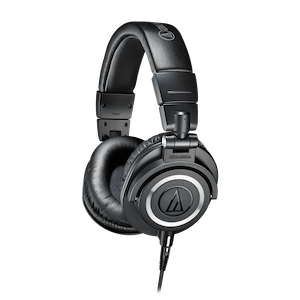
- Connectivity: Wired
- Frequency response: 15 – 20,000Hz
- Driver Size: 40mm
- Sensitivity: 96dB
- Enclosure: Closed Back
- Noise Cancellation: No
The M50X from Audio Technica’s ATH line has become one of the most reliable choices among users over the years.
This set of wired headphones is quite an all-rounder, offering crisp sound quality and decent isolation. Starting with the design, which is a standard plastic body with metallic headband adjustments.
The ear pads feel quite stiff before you break them in. However, we didn’t experience any discomfort even after hours of continuous use, except they trap heat, which can be a minor gripe for users in hot environments. And despite being all plastic, the build quality feels sturdy enough to last a long while.
The M50X are studio profile headphones that serve well for recordings. The sound bleeding is minimal, if not absent. But since they lack ANC, the ambient sounds can be quite noticeable, leaving them unfit for loud environments.
However, the sound quality generally is warm, with clear highs, mids, and lows. The treble frequencies are finely balanced, preventing ear fatigue during long studio sessions. The instrumental sounds are well-defined, with reasonable bass.
These headphones are a good choice for studio use as they fit comfortably and offer a satisfactory sound with minimal leakage.
2. Beyerdynamic DT 770 PRO
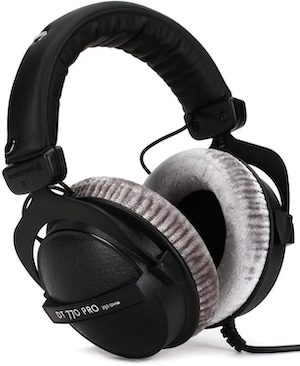
- Connectivity: Wired
- Frequency response: 5 – 35,000Hz
- Driver Size: 45mm
- Sensitivity: 96dB
- Enclosure: Closed-Back
- Noise Cancellation: No
The DT 770 Pro 80ohm headphone set is a must-have for many studio applications. Not only is it affordable, but it also delivers a flat-frequency sound with distinct details.
The Beyerdynamic 770 Pro boasts a robust construction, including a metallic frame and plastic-enclosed transducers. The ear pads feel comfortable with the microfiber covering and fit well for most people. Although there is no swivel or fold support, the headphones still offer reasonable room for adjusting to different head shapes.
The ear cups feel too tight right out of the box, but they are sufficiently padded and do not cause any major discomfort, even during prolonged use. However, if you’ve experienced the DT 880, this set feels quite a downgrade in terms of comfort.
Moving on to the sound quality, which makes up for the minor quibbles in the design and comfort. The DT 770 Pro are professional-level headphones offering impressive passive noise reduction. With these, you can easily focus on the recording without any distractions.
In addition, they’re great at preventing sound bleeds, so you don’t have to worry about unnecessary noise in your recordings either. High frequencies can get harsh sometimes, and lows are slightly closed sounding, but overall, you get a flat studio sound with crisp details.
In short, these headphones are well worth your money for studio-related applications.
3. Sennheiser Professional HD 280
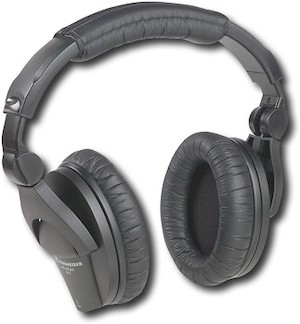
- Connectivity: Wired
- Frequency response: 8 – 20,000 Hz
- Driver Size: 40mm
- Sensitivity: 102dB
- Enclosure: Closed back
- Noise Cancellation: No
This wired headphone set by Sennheiser offers exceptional sound reproduction, good value for money, and reliable performance for studio applications.
The all-plastic construction of these headphones was not a wow moment at first sight. However, we found the build quality super solid and sturdy enough to withstand multiple drops. The ear cups are amply padded, with sufficient cushioning around the headband.
By the looks of it, the headphone seemed comfortable, but the experience was quite the opposite and underwhelming. The headband feels tight, and although the cushioning minimizes the clamping force, it can become uncomfortable during long sessions.
The sound quality is not for critical listening, to begin with. The bass is mediocre, as is the frequency response. However, these are the best headphones for recording vocals because they efficiently prevent sound bleeding. But due to the lack of canceling noise-canceling features, the headphones fail to muffle the surrounding sounds.
The high notes are not overly exaggerated, making the headphones good for mixing and monitoring the recordings. The mid-frequency response is even and fairly flat. The lows are crisp and detailed as well. Overall, the sound reproduction is amazing, and we consider the Sennheiser HD 280 Pro a worthy choice for music production.
4. Beats Studio 3 Headphones
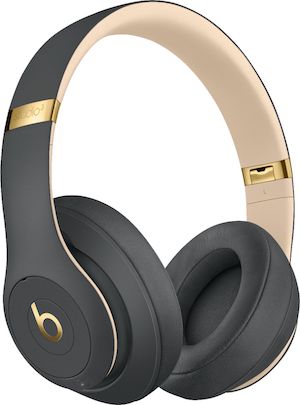
- Connectivity: Wireless
- Frequency response: 20 – 20,000 Hz
- Driver Size: 40mm
- Sensitivity:
- Enclosure: Closed Back
- Noise Cancellation: Yes
The Beats Studio 3 comes with some amazing specs, but the price tag is something we cannot justify, to be fair. Most competitor devices offer similar specs at a fairly lesser cost, but that’s that.
The design of the wireless headphones is a clone of the previous Studio 2 by Beats, which is fine as long as the comfort is there. The headphones boast a premium, sleek design with adequate ear cup padding. The headband cushion is fairly thin, but it frees the headset bulk.
The Studio 3 headphones stay in place even during physical activities and are fatigue-free for long listening sessions. And although Bluetooth headphones are not the first choice for recordings due to latency issues, we didn’t experience any trouble with that.
The sound is good but could be better in class. First, the frequency response needs to be more consistent. The sound delivery is immensely affected by the position and fit of the headphones. Second, the treble frequencies are not impressive, resulting in underemphasized vocals and instrumental sounds.
The bass accuracy, however, is excellent, as is the noise-canceling performance. They efficiently isolate the ambient sounds and allow little to no sound bleeding, which makes them an appropriate fit for studio applications as far as recording is concerned.
In short, if you’re a Beats fan, you’ll love Studio 3 even at $300. And while this is an excellent set of headphones, the market offers extraordinary devices in this range.
5. Beyerdynamic DT 990 Pro
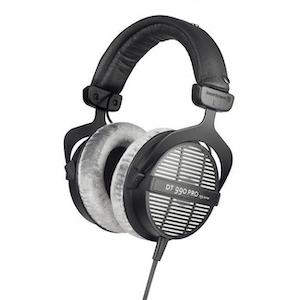
- Connectivity: Wired
- Frequency response: 5 – 35,000 Hz
- Driver Size: 45mm
- Sensitivity: 96dB
- Enclosure: Open Back
- Noise Cancellation: No
The DT 990 Pro is an excellent pair of headphones in terms of sound reproduction, rendering them a great choice for critical listening.
These headphones have a premium feel because of the rugged metallic construction finished with smooth, high-end cushioning. The ear cups feel cushy with velour-enclosed foam padding. The large ear cups sit nicely around the ears. However, the headband fits tightly on big head sizes to the point where it gets uncomfortable.
Overall, the build quality is sturdy except for the ear cups, made out of plastic and hence, more prone to damage, especially as the headphones fail to stay in place during physical activities.
The sound quality is impressive, as is expected from open-back headphones. With these headphones, you’ll experience a wide soundstage and frequency response. The bass response is slightly amplified, while the mids and lows are well-defined and unambiguous. The sound layers and nuances are fairly discernible, making these headphones the right fit to monitor the recordings.
However, the DT 990 Pro falls short in sound isolation and noise canceling. We noticed some sound leaks at high volumes, and isolation from ambient sound isn’t expected from open-back headphones.
But the sound quality is stellar, and you cannot beat them for the price.
6. Audio Technica ATH-M40X
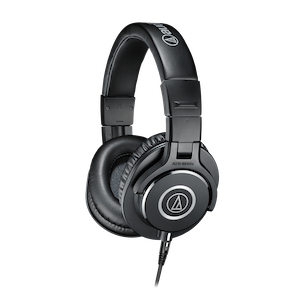
- Connectivity: Wired
- Frequency response: 15 – 24,000 Hz
- Driver Size: 40mm
- Sensitivity: 98dB
- Enclosure: Closed Back
- Noise Cancellation: No
The ATH-M40X is another great choice for recording vocals due to its studio-quality sound, comfortable fit, and passive isolation.
In terms of design, these headphones are quite similar to the ATH-M50X, which means they are fairly basic without any particular promising aspect about their design. However, that’s barely an issue because they’re comfortable and fit just right. And that’s exactly what we’re after.
The ear cups support a free swivel that allows much adjustment. But while the padding on the ear cups keeps you comfortable, it also retains heat which can be a problem in certain situations. The headphone’s construction is mostly plastic except for the metal headband, yet they feel sturdy and durable.
The sound quality may not be great for audiophiles, but it’s good enough for studio applications. The highs are crisp, and the mid-range frequencies are even and well-balanced. Even the lows sound pretty detailed.
In terms of isolation, these may not be the best. However, due to the closed-back design, they do a decent job of preventing sound leaks which is a significant issue while recording tracks. A minimal sound bleed can be noticed within the 500 to 4000 Hz frequency range. Overall, the sound response is reasonably flat, making it easy to analyze the recordings.
For the price, we think the ATH-M40X is a steal and a worthy option if you’re trying to produce music.
7. OneOdio Over Ear Pro 10 Headphones
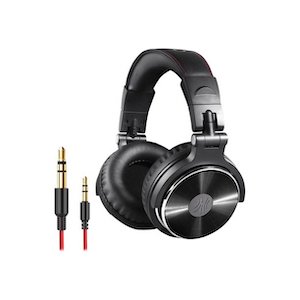
- Connectivity: Wired
- Frequency response: 20 Hz – 40,000 Hz
- Driver Size: 50mm
- Sensitivity: 110dB
- Enclosure: Closed Back
- Noise Cancellation: No
The OneOdio Pro 10 is a good pair of inexpensive, lightweight, and well-balanced headphones.
These headphones boast a minimalistic design with sufficient cushioning around the headband and thick padding around the ear cups, making the Pro 10 super comfortable for extended use.
In addition, they support a pivot and swivel function. Resultantly, the earpiece flips around too quickly, which can be annoying, but at the same time, this swivel function allows easy folding and improves portability.
Other than that, they have sturdy construction with firm ear cup padding, which is flexible enough to fit according to each head shape. As for the sound isolation, they’re good at it but not the best. There were no major sound leaks, except some high bass frequencies were noticeable.
These headphones deliver a very punchy bass and adequately enhanced mids and lows. However, they do not deliver a balanced sound which is why some treble frequencies sound exaggerated, but that’s understandable because they’re DJ headphones that are not meant for accuracy anyway.
Despite all the minor flaws, we think this is a decent choice if you’re starting and want inexpensive but comfortable headphones for recordings.
Best Headphones for Recording Vocals: Buying Guide
Some of the key features that you must consider before purchasing headphones for recording vocals or studio applications, in general, are listed below.
Enclosure Type
Over-the-ear headphones are available in 2 types of enclosures; open back and closed back. Both of them are suitable for different situations. For recording vocals and tracks, closed-back headphones are the ideal choice.
Closed-back headphones are better at sound isolation. They block out ambient sounds efficiently and allow you to record comfortably without surrounding distractions. In addition, most closed-back headphones prevent sound bleeding to a great extent as well.
Open-back headphones with active noise cancelling can be a good choice for a wide range of studio applications. They offer a clearer and more balanced sound quality and can be ideal for mixing and editing purposes.
Frequency Range
The wider the frequency range of the headphones, the better quality sound they produce. The frequency range represents the bass frequencies measured in Hz and treble frequencies in kHz. A typical human ear can hear frequencies from 20 Hz to 20 kHz. Therefore, most headphones offer frequencies within the same range.
At the same time, many headphones offer a wider range of frequencies which is not audible to the human ear, per se. Frequencies higher than the audible human ear range are not heard but felt. Most people cannot discern the differences, so headphones with a standard 20 Hz – 20kHz frequency are equally good choices.
However, headphones with a wider frequency range are recommended for studio editing.
Fit and Comfort
Choosing headphones that fit right is the key to ensuring comfort during long recording sessions. To ensure the headphones fit well, look for ones with larger ear cups and generous room for adjustments. Also, choose headphones with amply padded ear cups that feel comfortable and aid in isolation.
In addition, go for lightweight headphones because the bulk can cause a lot of fatigue during extended studio sessions and, consequently, lead to discomfort.
Build Quality
The headphones must have the decent build quality to stand the test of time. But the problem is that we cannot define what guarantees a good build quality. We’ve come across headphones with flimsy metallic frames and some sturdy options in plastic and vice versa.
Therefore, it is best to go for headphones from reliable brands. Conversely, you can choose any headphones from our list because they boast sturdy construction and top-notch build quality.
Cable Length
If you’re using headphones in a studio, you need ones with a long cable that allows you to move around and doesn’t restrain you to a single place. However, longer lines can affect the sound quality because they quickly pick up the noise and surrounding frequencies due to higher resistance.
But thankfully, the material of the cable can help you minimise that impact. A long line made of high-quality material eliminates the signal loss and hence, does not cause any compromise on the sound quality.
A high-quality copper cable can be a reliable choice when you’re looking to minimise the impact of the cable length on sound quality.
FAQ’s
Which earphone is best for voice recording?
Closed-back headphones are best for voice recording. They offer good sound isolation and prevent sound bleeding to a great extent, therefore, they’re highly recommended for voice recording.
Should I record vocals with headphones?
The right headphones allow you to record vocals without mic bleeds, and also, you can listen to backing tracks while you record. So yes, you should record songs with headphones.
Are open-back headphones better for recording vocals?
No, open-back headphones are generally not recommended for recording vocals because they do not offer good sound isolation and cause a lot of sound leaks. However, they’re good for mixing and editing as they offer superior sound quality.
What are studio recording headphones?
Studio recording headphones are different from regular headphones in that they are designed to produce sound as accurately as possible. Studio headphones should have a flat frequency response and produce sound as it was recorded. It also means they reveal all the flaws in the sound, which are then fixed during editing.

